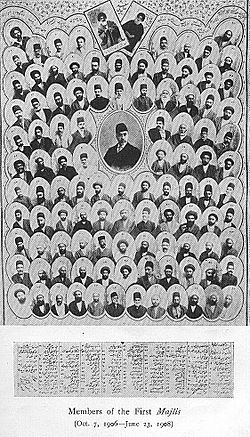|
Persian Constitution of 1906
 The Persian Constitution of 1906[2][3][4] (Persian: قانون اساسی مشروطه, romanized: Qānun-e Asāsi-ye Mashrute), was the first constitution of the Sublime State of Iran (Persia) and a result of the Persian Constitutional Revolution. It was written by Hassan Pirnia, Hossein Pirnia, and Esmail Momtaz, among others.[5] The Constitution was also in effect during Pahlavi Iran. It is divided into five chapters with many articles that developed over several years. The Quran was the foundation of this constitution while the Belgian constitution served as a partial model for the document, which guaranteed each citizen equality before the law, and a safeguarding of personal honour, property and speech.[6][7] The electoral and fundamental laws of 1906The electoral and fundamental laws of 1906 established the electoral system and the internal frameworks of the Majlis (Parliament) and the Senate. By the royal proclamation of August 5, 1906, Mozzafar ad-Din Shah created this first constitution "for the peace and tranquility of all the people of Persia." Mohammad Ali Shah Qajar is credited with chapters 4 and 5. The electoral law of September 9, 1906The electoral law of September 9, 1906 defined the regulations for the Elections to the Majlis. DisenfranchisedArticle 3 of this chapter stated that (1) women, (2) foreigners, (3) those under 25, (4) "persons notorious for mischievous opinions," (5) those with a criminal record, (6) active military personnel, and a few other groups are not permitted to vote. Election qualificationsArticle 4 stated that the elected must be (1) fully literate in Persian, (2) "they must be Iranian subjects of Iranian extraction," (3) "be locally known," (4) "not be in government employment," (5) be between 30 and 70 years old, and (6) "have some insight into affairs of State." Article 7 asserted, "Each elector has one vote and can only vote in one [social] class." The fundamental laws of December 30, 1906The fundamental laws of December 30, 1906 defined the role of the Majlis in the system and its framework. It further defined a bicameral legislature. Article 1 established the National Consultative Assembly[8] based "on justice." Article 43 stated, "There shall be constituted another Assembly, entitled the Senate." Constitutional Amendment of 1907Among the topics discussed in the amendment, was the declaration of Twelver Shi'ism as the state religion and establishment of a council of five high ranking Twelver Shia clerics tasked to make sure the laws passed by the parliament are not against the laws of Islam. Also among the topics were articles about the rights of the people and articles describing the flag of Iran and setting Tehran as the capital of the country. See alsoWikisource has original text related to this article:
References and notes
Further reading
External linksWikimedia Commons has media related to Persian Constitution of 1906.
Information related to Persian Constitution of 1906 |
||||||
Portal di Ensiklopedia Dunia
